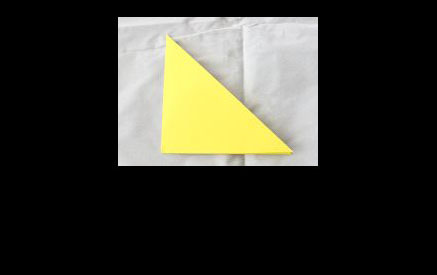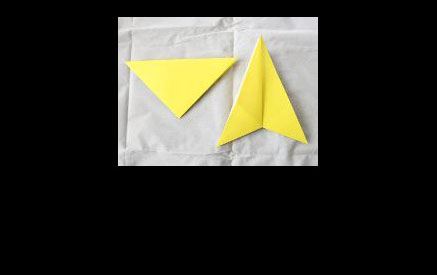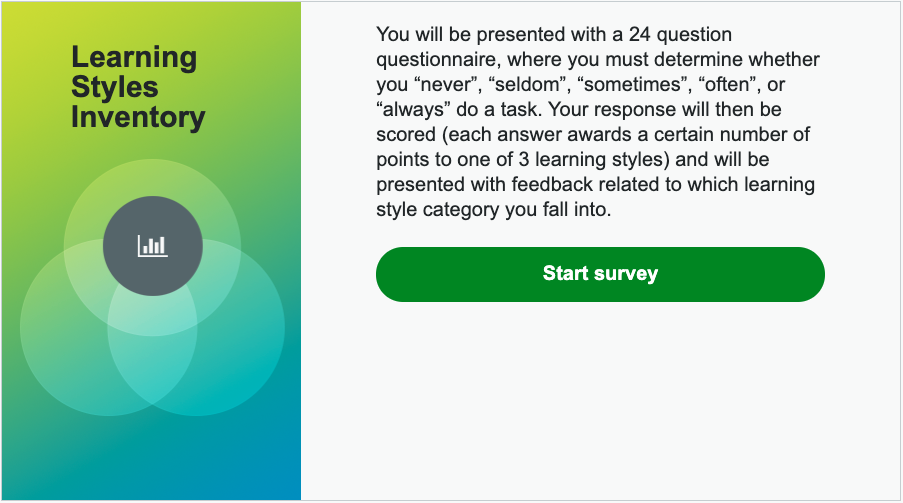Introduction

This course is all about discovering learning strategies that will make you a better, more self-sufficient learner. Focus on thinking, interpersonal, knowledge, communication, personal management, and planning skills. This course will hopefully make you more confident and motivated in your learning.
In this learning activity you will learn about your preferred learning style. You’ll identify which approach you rely on most when learning, and which approaches you can work on. You will then gather information about your preferred learning style. You will use this information both to explore new ways of learning and to discover the type of learning environment in which you can be most successful. Also, you will use your knowledge about your learning strengths and challenges to reflect on your past experiences as a learner. In turn, this will help you identify strategies for improving your learning.
How do I learn best?

This learning activity will take you on a journey where you will examine your learning experiences – both positive and negative – to help you determine what helps you to learn and what is not helpful. After examining your preferred learning style, you will look at some strategies that can help you use your strengths in any learning situation.
Preferences Example: Crossing your arms

Here is an activity that helps to illustrate the idea of preferences:
- Cross your arms.
- Take note of which arm is above the other.
- Now, re-cross your arms with the other arm on top.
For most people, the first way you crossed your arms will feel more natural – you did it without having to think about it. It is your preference. You can do it the other way, but it is not as comfortable. It’s not that one way is better than the other – either preference is fine. It’s just good to know what your preference is so you can recognize that there are “differences.” One way is more comfortable for you; another way could be more comfortable for someone else.
Can you think of something else that you do on a regular basis that is a preference that you have developed?
Press the following button to display the suggested answer.
Student Dev’s answer:
I always put my left shoe on before I put my right shoe on.
Preferences Example: Playing Hockey
To further illustrate the existence of preferences, here is another example. Imagine that you are a right-handed hockey player. For best results, most right-handed people use a right-handed stick – this is the way you’d learn how shoot and handle the hockey puck.

Once you have mastered your preferred way of shooting you can use what you know to learn to shoot from the other side. Learning styles are like that. You can learn how to use your preferred style in any environment and build on that strength to develop other ways of learning.
What is something that you would find very uncomfortable to do with your “opposite” hand?
Press the following button to display the suggested answer.
Student Mohammad’s answer:
I would find it really uncomfortable to have to write with my left hand, since I am right-handed.
There are many different ways to determine your preferred learning style. In this learning activity, and in future learning activities, you will complete what is known as an inventory – a questionnaire that will help you to understand why you sometimes learn things very easily, but may have difficulty learning at other times, in other situations. Throughout the rest of this course, you will deepen your understanding of yourself as a learner. For example, later in the course, you will examine the ways in which you demonstrate intelligence and you will look at the ways in which your emotions affect your success as a learner.
Next, you will learn more about the three different styles of learning.
The Three Main Learning Styles
There are many ways to learn. You will probably find that although you use all three styles at different times, you prefer one style to the others. These are the three main learning styles:
- visual (learn by seeing)
- auditory (learn by listening)
- kinesthetic or tactile (learn by doing)

The following descriptions provide some general characteristics or attributes of the three types of learners. Keep in mind that no one fits only one learning style – each of us uses all of the learning styles at different times.
So you will probably recognize something of yourself in each category, but one of the three categories will describe you best.
Learning a new task with different learning styles
Now that you are more familiar with the three types of learning styles, let’s see how they can be implemented.
Activity
You are going to be asked to make an origami star, which simply involves folding a piece of paper in a very specific way, following step-by-step instructions. Since you are going to try to create a star by following each of the three preferred learning styles, you will need three pieces of paper for this activity.

Origami star: Kinesthetic learning
First, you will create a star using a method preferred by kinesthetic learners. You will be given a set of step-by-step instructions along with images of what you should be doing at each step. You will be creating the star as you go through each step!
Get two pieces of square (not rectangular) paper and follow along. If you don’t have any square paper, you can just cut a piece of rectangular paper into a square, ensuring that your paper has four equal sides.
How did you do after following along with the step-by-step instructions? What was the most challenging part of the process?
Press the following button to display the suggested answer.
Student Ali’s answer:
I really struggled and got super confused just making it while I looked at each step. My example looks nothing like a star and I am frustrated.
Origami star: Auditory learning
The second way you will learn this task will be through listening to a set of instructions as you make your next star. Listen to the following audio recording of someone talking you through the process of making this origami star. Again, try your best to create the star. Some of you will find this easier than others, depending on how you prefer to learn.
Listen
How did you do after hearing someone describe how to create the star? What was the most challenging part of the process?
Press the following button to display the suggested answer.
Student Ali’s answer:
I still found this exercise really hard to do. Listening offered me a bit more help, but the person spoke too fast for me and I had a hard time trying to keep up.
Origami star: Visual learning
Watch This!
Finally, you are going to try and make the star while watching a video of someone completing the same task.
How did you do after watching someone create the star? What was the most challenging part of the process?
Press the following button to display the suggested answer.
Student Ali’s answer:
I found it much easier to do this with a video showing me exactly what I should be doing and how I should be folding my paper. My star actually looks like a star now.
You may have found that it was a difficult task until you had all three ways of learning presented to you in order to create this star. Sometimes, even though you have a stronger “identified” learning style, other ways of learning can enhance or cement concepts for you that are tricky.
This means that if you have primarily identified yourself as a visual learner, you shouldn’t ignore other ways to learn. Sometimes, using multiple learning styles allows you to master a task faster.
Are you beginning to get an idea of where you might fit within these three different styles of learning? In this next section, you will identify which type of learner you identify the most with.
Knowing and Using Your Own Learning Style
Knowing your preferred learning style can help you to learn things more effectively. If you know which of the styles you are most comfortable with (the one you prefer), you can adapt the way you approach a new subject in order to become more effective as a learner.
For example, if you have trouble following a written list of instructions because you are a kinesthetic learner (someone who learns best through hands-on or participatory activities), you can ask someone to demonstrate the task for you (or guide you through it as you do it yourself). You will then be able to perform the task and read the instructions later to ensure that you haven’t left out any steps. When you begin a task with your preferred learning style, you will set yourself up for success. When you follow up by reading the instructions, you work on strengthening your weaker learning styles.

Learning Styles Inventory

Learning is a complicated process and many factors influence it. It is important to remember that each activity in this course provides you with one small piece of the puzzle that represents you as a learner. In this first learning activity, you will begin by exploring your preferred style of learning. Remember that this is not the complete picture of yourself as a learner, but rather just one piece of the puzzle.
Complete the activity on the following page to determine your preferred learning style. Although the results of this inventory cannot tell you everything about how you learn, they will provide you with some important information that can help you develop a learning improvement plan.
Click here for an accessible version of Learning styles inventory. (Opens in new window)
Learning Style Profile

Now that you’ve finished your inventory, complete the following learning style profile for yourself.
My preferred learning style is:
Press the following button to display the suggested answer.
Student Rohan’s answer:
According to the learning style inventory, I am an auditory learner.
Related to my preferred learning style, I enjoy activities that involve the following:
Press the following button to display the suggested answer.
Student Rohan’s answer:
Listening to music, watching movies, watching YouTube, Playing video games, going to concerts.
Related to my preferred learning style, I learn best from a teacher who does the following:
Press the following button to display the suggested answer.
Student Rohan’s answer:
Allows me to record lectures, lets me listen to music while I work independently, and shows videos during class.
Related to my preferred learning style, I like to work in a work or study area that includes the following:
Press the following button to display the suggested answer.
Student Rohan’s answer:
Has soft music playing, has a lot of technology, and allows me to work in a group setting.
Now that you have a better idea of your personal learning style, in the next section you will take a look at making the most of those learning preferences.
Making the Most of Your Learning Preferences

Every learning situation is different. Some learning activities are suited to an individual’s preferred learning style, and others are not. Think about your own experiences in school. The activities that you enjoyed the most were probably those that allowed you to learn in your preferred learning style. Ever thought that every teacher has their own preferred learning style? This preference will affect the way they present information. Here are some examples of teachers who present information in particular ways.
The preferred learning styles of teachers
Identify which learning style each teacher likely prefers.
You can often predict a teacher’s learning style by watching how they teach. If you have a teacher who creates activities that relate well to your learning style, you will probably do better in their class. For example, if you are an auditory learner, and your teacher gives detailed oral explanations, you will probably feel very comfortable in that class and will pick things up quickly. Or, if you are a kinesthetic learner and your teacher provides lots of hands-on materials, you are more likely to enjoy and excel in that class.
Adapting to other learning styles
Clearly, not all learning activities will be geared to your favourite ways of learning. Sometimes you will be asked to perform tasks that rely on your weaker or less preferred learning styles. If at all possible, try to use your preferred learning style to help you with the task.
Identify the learning style that is most challenging for you. Give an example of a learning situation that required you to use that learning style and describe why it was challenging.
Press the following button to display the suggested answer.
Student Bella’s answer:
The learning style that is most challenging for me is auditory learning. In French class, I had a listening exam and had to listen to the teacher say 30 questions in French and had to choose my response. This was difficult because I couldn’t picture the words and had to sit still and not write anything down until she was finished speaking.
Describe a learning situation that was difficult for you because you were not able to use your preferred learning style.
Press the following button to display the suggested answer.
Student Andrea’s answer:
I am a visual learner and I had a history teacher who just stood at the front of the room and talked to us about different events in history. I found this class very difficult because I couldn’t remember anything he said and he talked so fast I couldn’t write everything down that I needed to.
What would have made that learning experience better for you? Review the strategies you just learned to give you some ideas.
Press the following button to display the suggested answer.
Student Andrea’s answer:
If the teacher had used more technology, videos, pictures or images it would have gone a long way in helping me understand the content. One of my old history teachers always used timelines to demonstrate when events happened and I always found that really helpful.
Once you understand your learning style, you can use your strengths to help you to learn. When you are confident using your learning style, you can incorporate other ways of learning. This will make you more flexible as a learner, so you will be comfortable in a greater range of learning activities.
Teaching those with different learning styles

Being aware that different people have different learning styles can also help you teach others in a more effective manner. In order to better understand this, you will assume the role of a teacher or a coach and teach a skill in a way that is geared towards the preferred learning style of your students rather than your own.
Think of a skill that you have mastered. Perhaps you are an excellent soccer player or visual artist, an expert knitter or a gifted musician. Perhaps you have great organizational skills in general, or an in-depth knowledge of a particular topic.
Now imagine that you have been asked to teach your skill to three different students, each of whom has a different preferred learning style – visual, auditory, and kinesthetic. What strategies would you use with each student to make them as comfortable as possible throughout the learning process?
Identify the skill that you are going to teach:
Press the following button to display the suggested answer.
Student Lise’s answer:
I would teach them how to shoot a foul shot in basketball. I’m a talented basketball player and am especially good at making foul shots.
What strategies would you use with each student to make them as comfortable as possible throughout the learning process?
Visual learner
Press the following button to display the suggested answer.
Student Lise’s answer:
For a visual learner, I would demonstrate each step in shooting a foul shot so that they could see for themselves what it should look like. I would then show them several video clips of basketball players taking foul shots as well. Finally, I would videotape them as they tried taking foul shots so that they could play back their attempts to see which steps they could improve upon.
Auditory learner
Press the following button to display the suggested answer.
Student Lise’s answer:
For an auditory learner, I would allow them to record my voice explaining each of the steps and then have them listen to my voice for each step as they tried it themselves.
Kinesthetic learner
Press the following button to display the suggested answer.
Student Lise’s answer:
For a kinesthetic learner, I would take them to a court and show them how to make a foul shot and then have them try it themselves. After they have practised for a while we could isolate any step they are having trouble with and try to fix the specific issue they are having before they start to practise again.
Extending Your Learning Beyond School

Although this course is designed to help you to do better in school, it is important to remember that almost everything that you do in life will involve learning. This is certainly true of career exploration.
Complete the working style assessment quiz on the following page to find connections between your learning preferences and your preferred working style.
Click here for an accessible version of Working style assessment quiz. (Opens in new window)
Working style assessment quiz
List any connections you found between your preferred learning styles and the workplace preferences identified in the activity you just finished. How do your preferred learning styles relate to your work preferences?
Press the following button to display the suggested answer.
Student Yosef’s answer:
I am a kinesthetic learner and was identified as expressive in the workplace quiz. These two preferences overlap because I like new things and love to jump from one thing to another. I also work well with others and love to come up with new ideas.
In your notes, save the results of this activity. You will use them in the future learning activities when you set goals, make an action plan, and explore employment options for the future.
Conclusion

The work you have done in this learning activity will help you to develop strategies to apply your preferred learning style in a variety of learning situations. As mentioned earlier, these strategies are just the beginning. In future learning activities, you will be introduced to many other skills and strategies, including:
- problem-solving
- time management
- teamwork skills
- note-taking
- effective presentations
- preparing for and taking tests
- dealing with stress
- setting goals
- creating plans
- accessing resources
- researching occupations
- educational planning
- financial planning
The combination of skills and strategies learned in this course will help prepare you for any learning situation.























